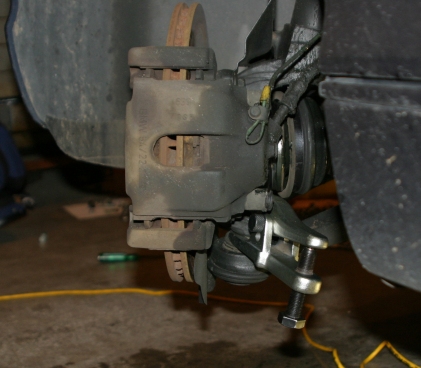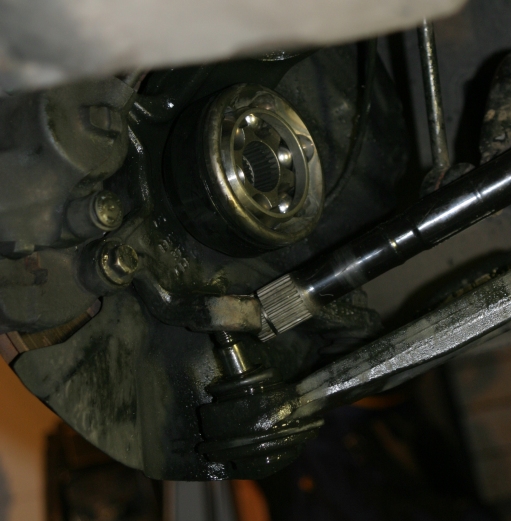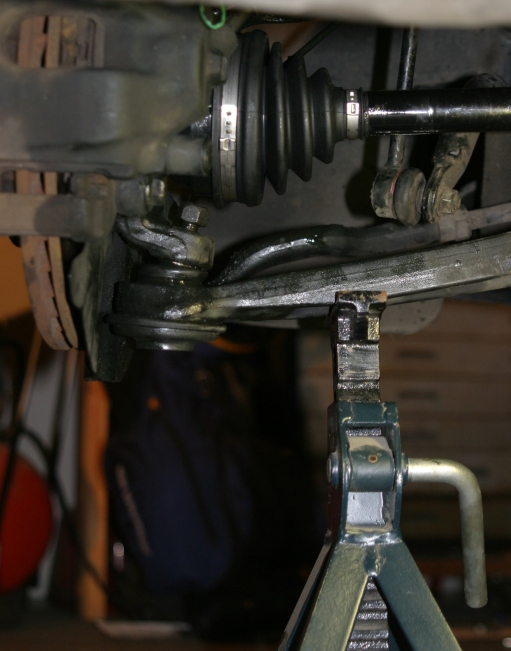
home
The Process
|
|
Thanks for visiting the website and if you are here, you are probably wondering about how to repair your leaking CVJ boots. I also did the same, and designed a tool to deal with the problem of replacing the boots without all the disassembly required in all the other procedures. This illustration is on a 2006 BMW 325XI. Here's the original CVJ Axle Press: A typical CVJ boot repair requires disassembly of the entire front suspension. This is because there is no real good way to swing a hammer at the CVJ joint when it is still mounted in the axle bearing. The axle bearing would dissipate much of blow, and the possibility of damage to the brakes, wheel speed sensor, etc is too great. The idea is to put pressure on the inner CVJ to axle connection in order to pop the joint apart in a clean, controlled manner.
The original tool used four 1/4" bolts to clamp the press halves together. In using the tool, getting the holes to line up to start the bolts proved to be a headache. This unit has a 5/16" studded press clamp, and is much easier to use when movement is limited under the car. I also added the re-assembly turnbuckle to the same clamp to simplify the procedure.
I slotted the push plate rather than use a band clamp to hold the original two pieces together, another improvement on ease of use. The pressure needed to pop the CVJ from the axle is nowhere near the original level of construction. The original carriage bolts are 1/2". The new design uses 5/16" press bolts threaded through the tool, and the latest design only uses two 3/8" press bolts. The pusher plate has an extension so that the tool pushed on the CVJ itself, and not the bowl housing. It's hard to get the axle to line up square with the CVJ bowl housing, so the extension allows easier use. Ok enough of the lead in explanations, Here's the repair in detail:
I alternated between two of the bolts, using a wrench on the flats of the press bolt and the nut to push the joint apart. You probably now understand why I redesigned the tool to use a through thread press bolt. With the limited work environment that presents itself on a creeper, trying to swing two wrenches proved to be frustrating. Once the Cir-Clip popped, I could just use one of the press bolts to push the joint apart the rest of the way.
You can easily draw the axle into the CVJ by turning the turnbuckle by hand for about 3/4 of the way. To start, pull the axle in up to the cir-clip, then put a very slight amount of pull on it as you push the cir-clip in with a flat screwdriver. If you can't turn the turnbuckle by hand, your cir-clip is not seated and you are binding on it. Back off on the turnbuckle and start again. Make sure the open side of the cir-clip is pointing toward the floor. Easier to get to that way. I spoke with a garage mechanic, and he said that built this way, this tool would work with 85-90% of the cars made. If you don't have a BMW, measure your axle diameter. The standard BMW axle diameter is just shy of 1" so if your car is the same, the unit should work. If you have a different axle diameter, contact me and I'll make sure that your tool will fit your axle diameter. |















